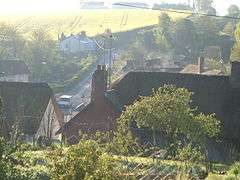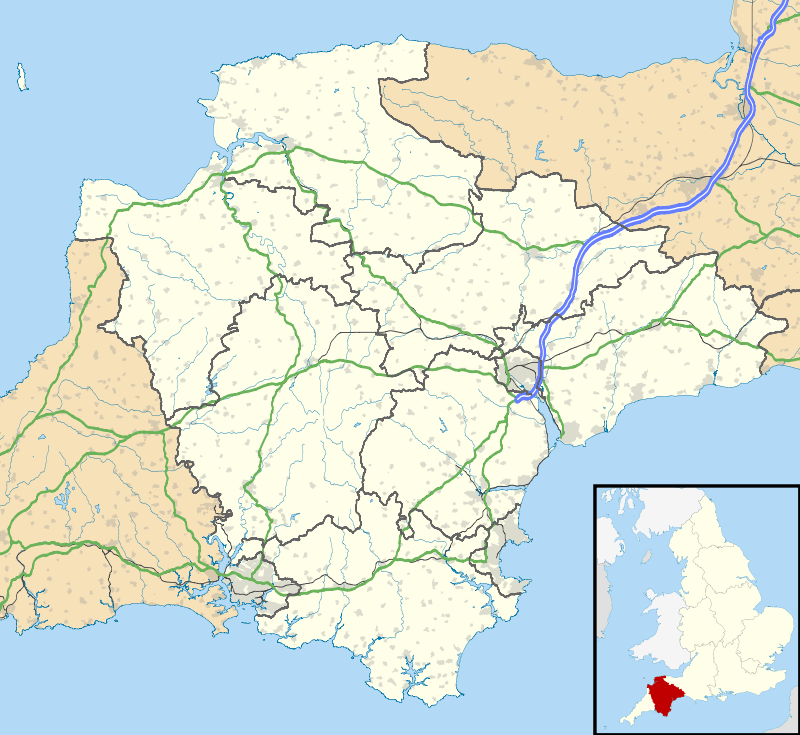Newton St Cyres
| Newton St Cyres | |
|---|---|
 Newton St Cyres | |
 Newton St Cyres Newton St Cyres shown within Devon | |
| Population | 562 (2011) |
| OS grid reference | SX8897 |
| Civil parish |
|
| District | |
| Shire county | |
| Region | |
| Country | England |
| Sovereign state | United Kingdom |
| Post town | EXETER |
| Postcode district | EX5 |
| Dialling code | 01392 |
| Police | Devon and Cornwall |
| Fire | Devon and Somerset |
| Ambulance | South Western |
| EU Parliament | South West England |
| UK Parliament | |
Newton St Cyres is a village, civil parish former manor and former ecclesiastical parish in Mid Devon, in the English county of Devon, located between Crediton and Exeter. It had a population of 562 at the 2011 Census.[1] The village is part of the Newbrooke electoral ward. The ward population at the above census was 1,520.[2] Almost destroyed by fire in the early 1960s,[3] its main point of interest is the Parish Church, built in the 15th century and dedicated to the martyrs St. Cyriac and his mother St. Julitta.[4] Most of the church is in early Perpendicular style, built of local reddish 'trap', a volcanic stone from quarries at Posbury, with the exception of the nave pillars, which are of Beer stone.[5] It contains the monument with standing effigy of John Northcote (1570-1632) of Hayne, lord of the manor of Newton St Cyres. Newton St Cyres railway station serves the Exeter to Barnstaple line.
Newton St Cyres is home to two public houses: the Crown and Sceptre and the Beer Engine. Traditional cheeses can be bought from the Quickes Farm shop. The village has a recreation ground with two football pitches, a cricket pitch and two tennis courts.[6]
Historic estates
The parish of Newton St Cyres contains various historic estates including:
- Newton House, built circa 1770 by John VI Quicke (1724-1776), (i.e. "the 6th"), Sheriff of Devon in 1757,[7][8] whose monument survives in Newton St Cyres Church. In 1810 his son John VII Quicke (1759-1830) of Newton House, was lord of the manor of Newton St Cyres.[9] The location of the house was marred by the presence of the busy main-road between Crediton and Exeter,[10] which passed almost next to the house and separated it from the parish church. To ameliorate the situation, at some time before 1797,[11] John VII Quicke employed soldiers returning from the Napoleonic Wars to lower the road by digging out a 50 foot deep cutting, over which he built a private footbridge linking his house with the church yard. Thus the house now appears sited at the edge of a cliff,[12] as is illustrated in a 1797 watercolour by Rev. John Swete.[13] The house burned down in 1906, but was rebuilt in 1909. It was converted into flats[14] and sold by the Quicke family, which in 1967 had abandoned it in favour of nearby Sherwood within the same parish.[15]
- Sherwood House,[16] built in 1918 by Adrian Cave, to the design of his cousin the architect Walter Cave[17] of Sidbury, in the Arts and Crafts style.[18] It was occupied by the Quicke family, which had abandoned nearby Newton House, from 1967 until its sale in February 2017. The business known as Quicke's Cheeses was established by John X Quicke (i.e.the 10th), using milk from the 2,400 acre[19] estate in the parish still owned by his family. He served as chairman of the Ministry of Agriculture's Regional Board 1972-5.[20]
- Hayne, ancient seat of the Northcote family, in 1885 elevated to the peerage as Viscount St Cyres of Newton St Cyres and Earl of Iddesleigh. Demolished prior to 1797.[21] The Northcotes moved to Pynes in the parish of Upton Pyne, Devon.
References
- ↑ "Parish population 2011". Retrieved 22 February 2015.
- ↑ "Newbrooke ward 2011". Retrieved 22 February 2015.
- ↑ "Settlement Character Part 3" (PDF). Mid Devon District Council. Retrieved 15 July 2016.
- ↑ N. Pevsner, The buildings of England - South Devon
- ↑ http://www.britainexpress.com/counties/devon/churches/Newton-St-Cyres.htm
- ↑ http://www.middevon.gov.uk/newtonstcyres/index.cfm?articleid=4054
- ↑ Date of building per Gray, Todd & Rowe, Margery (Eds.), Travels in Georgian Devon: The Illustrated Journals of The Reverend John Swete, 1789-1800, 4 vols., Tiverton, 1999, vol.3, p.126 Swete writing in 1797 "somewhat more than 20 years ago"
- ↑ Builder identified as John VI Quicke (1724-1776) by Swete, vol.3, p.126 "built by the father of the present proprietor" (who in 1797 was John VII Quicke (1759-1830) (dates see: Vivian, Lt.Col. J.L., (Ed.) The Visitations of the County of Devon: Comprising the Heralds' Visitations of 1531, 1564 & 1620, Exeter, 1895, pp.854-5, pedigree of Quicke
- ↑ Risdon, Tristram (d.1640), Survey of Devon, 1811 edition, London, 1811, with 1810 Additions, p.373
- ↑ Swete, Vol.3, p.126; Lauder, p.126-7
- ↑ Swete, Vol.3, p.126, 1797, notes the presence of "an under-road excavated from the rock"
- ↑ Swete, Vol.3, p.126
- ↑ Swete, Vol.3, p.128
- ↑ Lauder, p.130
- ↑ Lauder, p.129
- ↑ Lauder, Rosemary, Devon Families, Tiverton, 2002, p.129, sold by Savilles estate agent February 2017, £1.5M
- ↑ Pevsner, Nikolaus & Cherry, Bridget, The Buildings of England: Devon, London, 2004, p.597
- ↑ Lauder, p.129
- ↑ Lauder, p.127
- ↑ Lauder, p.129
- ↑ Swete, Vol.3, p.126
External links
Newton St Cyres at Curlie (based on DMOZ)
![]()